Cancer knowledge check
To begin, let’s check your knowledge and awareness of cancer.
Read each statement and check the most relevant check box on the right.
| I know | I have heard this before |
I did not know |
||
|---|---|---|---|---|
| Q1. | Around two-thirds men develop cancer. | |||
| Q2. | Around half of women develop cancer. | |||
| Q3. | Cancer is the leading cause of death in Japan. | |||
| Q4. | Nearly one-third of Japanese die from cancer. | |||
| Q5. | The cancer mortality rate people in Japan is 1.5 times that in the United States. | |||
| Q6. | The peak age of onset of breast cancer is the late forties. | |||
| Q7. | The peak age of onset of cervical cancer is the early thirties. | |||
| Q8. | Even healthy individuals develop many potentially cancerous cells every day. | |||
| Q9. | At the early stages of cancer development, more than 90% of cancer is entirely curable in the early stages. | |||
| Q10. | Localized cancer, which remains within the primary site, is relatively easy to remove. Cancer that does not stay localized but spreads to other body parts may be difficult to remove. Early detection by screening is essential. | |||
| Q11. | Because early stages of cancer present few symptoms, cancer screening are essential for detecting cancer before symptoms appear. | |||
| Q12. | Some cancer patients with work can be treated without hospitalization. | |||
| Q13. | Infection by certain bacteria or viruses could cause cancer. | |||
| Q14. | Knowing the company system to support the cancer treatments. | |||
| Q15. | Knowing the company's consultation service of health. |
Your cancer knowledge check results
Have a long way to go
Not bad, try better
Have moderate interest
Have high knowledge
-
30-26 points Have high knowledgeYou are familiar with and highly aware of "cancer".
Please proceed with learning in this course to reconfirm your knowledge. -
25-16 points Have moderate interestYou are interested in "cancer" and are constantly collecting information.
This course introduces a wide range of topics, from the mechanism of cancer onset to the measures that can be taken on a daily basis.
Deepen your knowledge through learning. -
15-6 points Not bad, try betterYou know general information about "cancer".
This course introduces a wide range of topics, from the mechanism of cancer onset to the measures that can be taken on a daily basis.
Deepen your knowledge through learning. -
5-0 points Have a long way to goYou don't seem to know much about cancer yet.
To deepen your knowledge, please proceed with learning in this course, which introduces a variety of topics regarding cancer, ranging from onset mechanisms to routine prevention practices.
Cancer literacy check
Cancer literacy check
- Next, we will ask each of the following questions as to whether each is easy or difficult for you.
Please choose the one that best applies to each answer.
| Very easy |
Somewhat easy |
Somewhat difficult |
Very difficult |
Don’t know or N/A |
||
|---|---|---|---|---|---|---|
| Q1. | Finding out what to do in case of cancer suspected | |||||
| Q2. | Understanding how to deal with cancer | |||||
| Q3. | Judging the advantages and disadvantages when some cancer treatments are available | |||||
| Q4. | Identifying opinions of people around you and leading a lifestyle to prevent cancer occurrence | |||||
| Q5. | Finding out how to undergo cancer screenings | |||||
| Q6. | Understanding what behaviors and lifestyles increase a cancer risk | |||||
| Q7. | Judging the advantages and disadvantages of cancer screenings | |||||
| Q8. | Avoiding lifestyles that increase a cancer risk based on your knowledge | |||||
| Q9. | Finding information on how your local government deals with cancer preventions | |||||
| Q10. | Understanding what political changes affect cancer preventions | |||||
| Q11. | Judging what initiatives for cancer prevention from your local government are appropriate | |||||
| Q12. | Sharing correct cancer knowledge and prevention methods with friends and people around you |
Your pre-course after e-learning literacy score is...
your cancer literacy Deviation value is...
 0
0
What’s literacy?
Health literacy is known as “the personal characteristics and social resources needed for individuals and communities to access, understand, appraise and use information and services to make decisions about health”.The "cancer literacy" mentioned above is a check item created by our group, and it is known that the higher the score, the more correct action can be taken against cancer.
Introduction
Introduction
In Corporate action for promoting cancer control, we have created e-learning "Cancer prevention and Work-Life Balance support" for improvement of cancer screening consultation rate and support for balancing cancer treatment and employment at partner companies.
The "trump card" for cancer control and cancer prevention is to know about cancer. Through this e-learning, we hope that you will acquire basic knowledge about cancer and protect your life and body from this disease.
This e-learning consists of four sessions. Sessions I to III are for all employees, and Session IV is for managers (which is optional for employees other than managers).
The English version of e-learning, "This material has been designed for Japanese originally."
- Learning goals
-
- ・ Acquire basic knowledge about cancer
- ・ Understanding the importance of cancer prevention and cancer screening
- ・ Understanding support for balancing work and cancer treatment
Message from Dr. Keiichi Nakagawa, University of Tokyo Hospital
Hello, I'm Dr. Nakagawa from the University of Tokyo Hospital.
Cancer is not "other person's affairs". Two out of every three Japanese men and one out of every two women develop cancer. Approximately 1 million people are newly diagnosed with cancer each year, and nearly 380,000 people die from this disease.
This rate is one of the highest in the world. The number of cancer deaths per 100,000 population in Japan is 1.6 times that of the United States, and recently it has nearly doubled. Deaths from cancer, which are declining in Europe and the United States, but continue to increase in Japan. Why?
The cause is the aging of the population, but it can be said that the major cause is that the Japanese are not aware of the disease called cancer. Cancer is a disease that can make a big difference in fate with a little knowledge and actions based on it. The "trump card" to prevent cancer from dying is to practice lifestyles to prevent cancer and cancer screening for early detection as a set.
If found early, 90% or 95% of most cancers will be completely cured. However, the cancer screening rate in Japan remains at the lowest level in developed countries. For example, the cancer screening rate for cervical cancer is more than 80% in the United States, but only about 40% in Japan. Such a shameful story.
Through this e-Learning, I hope that you will acquire basic knowledge about cancer and protect your life and body from this disease. We would like you to know about cancer.
1.Most effective mean to preventing cancer is to understand cancer!
01 Most effective mean to preventing cancer is to understand cancer!
Everyone may get cancer
- Two-thirds of men and half of women develop cancer.
- More young women especially are developing cancer.
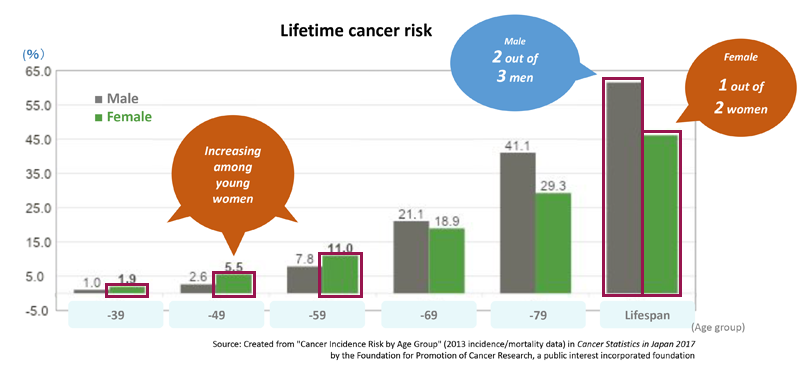
Why do people get cancer?
- Cancer develops fromcopying errors in cells (genes mutate) during cell division.

Malignant tumor (cancer) and benign tumor
- A benign tumor, if removed, is not life-threatening.
- Cancer that remains localized is relatively easy to cure. (Early stage)
- However, if cancer metastasizes, it is difficult to cure completely. (Advanced stage)
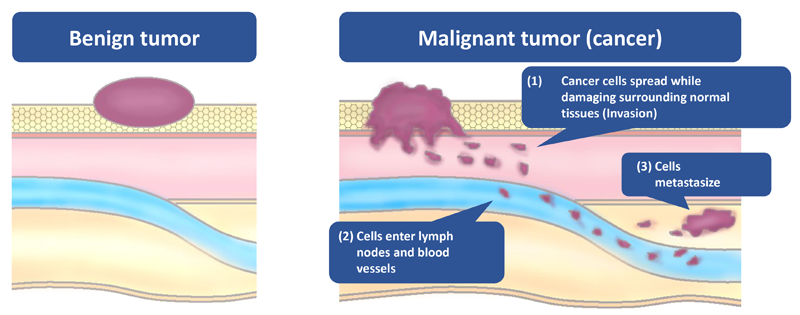
Japan, the world's top country for longevity, has the highest cancer rate among all countries
- A lot of cancer cells (5,000) develop in us every day.
- As we age, the number of copying errors during cell division increases, and the function of the immune system to destroy cancer cells diminishes.
- For this reason, if you live longer, you are more likely to get cancer.
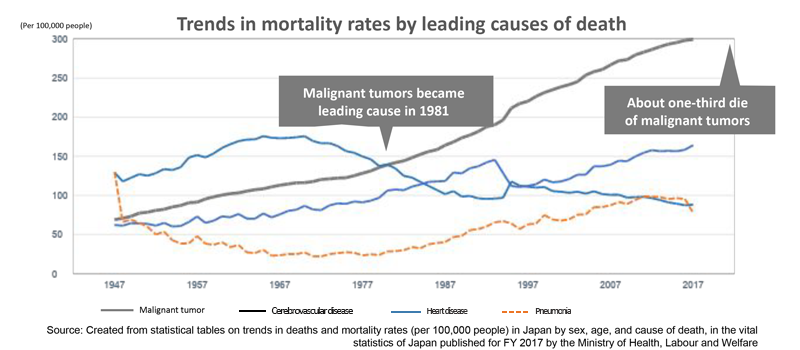
30% of cancer patients continue to work
- Along with an aging society, the number of older cancer patients is increasing.
- An increasing number of cancer patients are young women.
- With working years extended and more women working, more and more cancer patients are of working age.
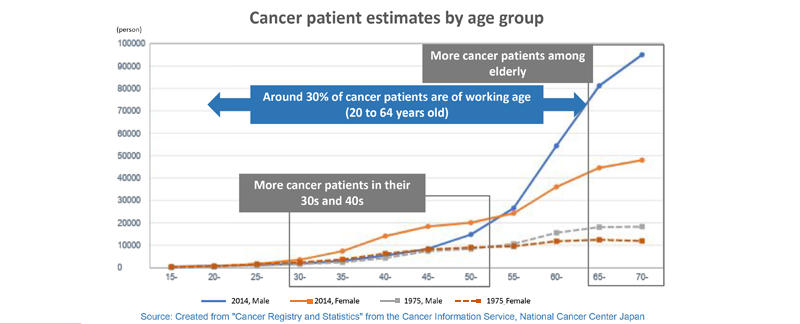
Japan is an undeveloped country in fighting cancer
- The cancer mortality rate is increasing in Japan but decreasing in the United States.
- As of 2016, the cancer mortality rate in Japan has been1.6 times that in the United States.
- The leading factor of the increase in the cancer mortality rate is a rapidly aging society. Nonetheless, poor cancer prevention activities (high smoking rate, low screening rate, etc.) contribute to the high mortality rate.
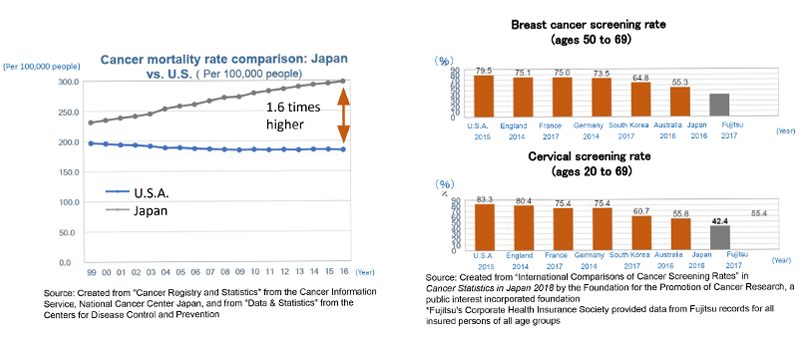
Cancer can be prevented
- More than halfof the cancers in men and up to 30% of the cancers in women are attributed to preventable causes.
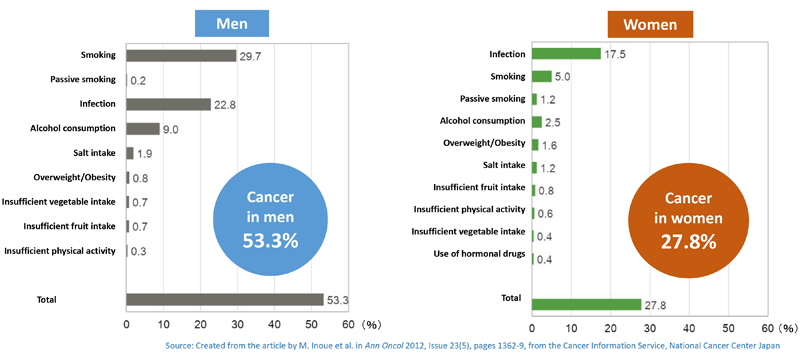
Lifestyle control for cancer prevention (1) smoking cessation
- Looking at causes of death by the organ system, lung cancer is No. 1.
- Cigarette smoking causes not only lung cancer but also cancer of the throat, pancreas, liver, and other organs throughout the entire body.
- Eliminating cigarettes would reduce male deaths from cancer by 40% in Japan.
- Cigarette smoke harms the health of people around smokers.
- Reports of health problems due to e-cigarettes/HTPs (heated tobacco products) are also increasing.

Lifestyle control for cancer prevention (2) alcohol consumption and physical activity
- Drink alcohol in moderation - For example, if your face turns red when you drink alcohol, drink with care. –
- Even a little physical activity can have a positive impact.
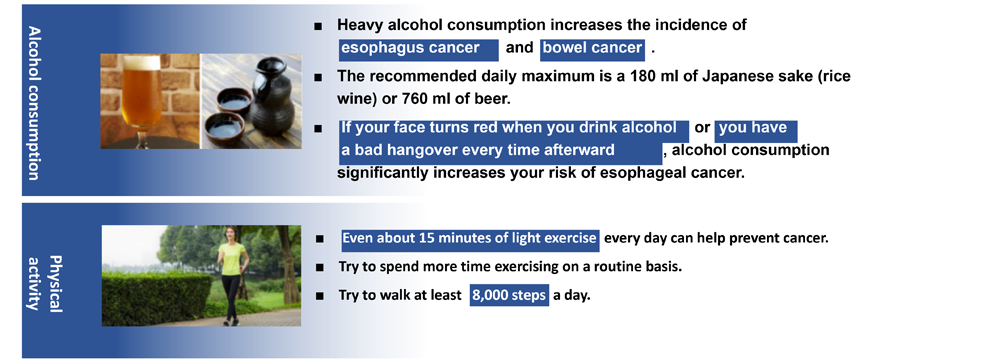
Lifestyle control for cancer prevention (3) diet
- Eat meat in moderation. Be sure to eat vegetables and fruit every day.
- Be careful to limit your salt intake and avoid scalding hot drinks or food.
- A balanced diet is the best way to prevent cancer.
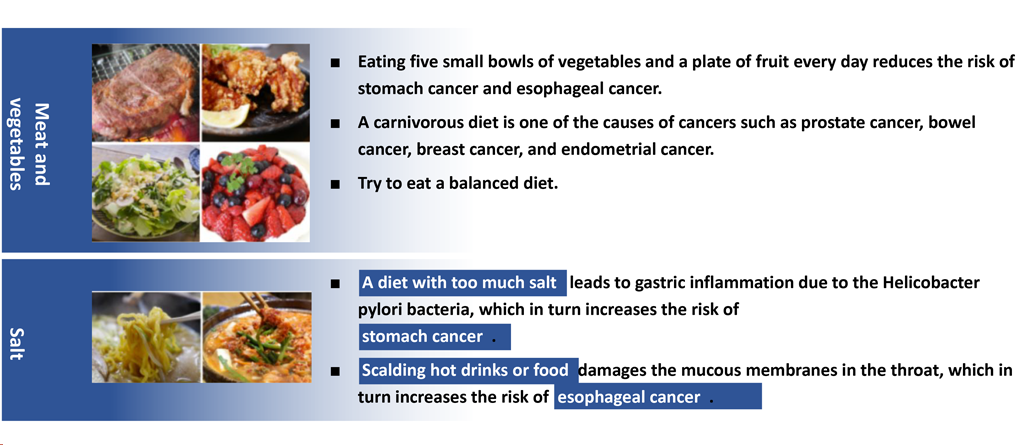
Cancer also caused by infection
- Around 20%of cancer incidence in Japan is due to infectionswith bacteria or viruses. (Around 5% in Europe and the United States)
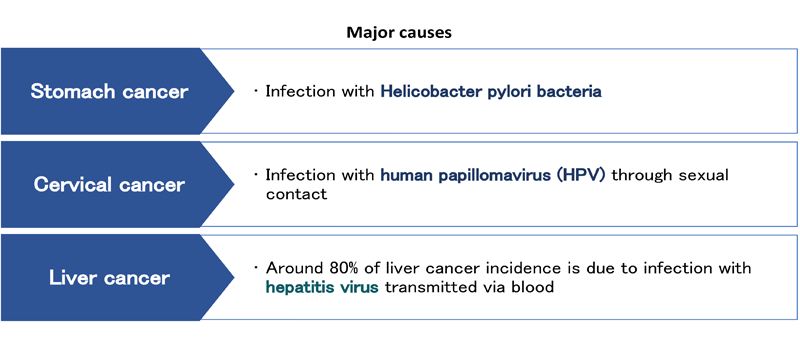
What should men be careful about?
- Smoking cessation and control of alcohol consumption can reduce the risk of cancer development in men by around 40% .
- Infection accounts foraround 20% of cancer incidence in Japanese men too.
- Try to get examinations early to determine whether you are infected with the Helicobacter pylori bacteria or hepatitis virus.
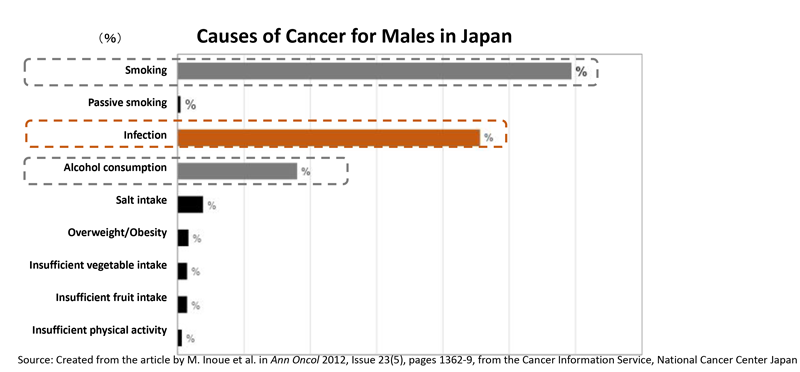
What should women be careful about?
- Cancers specific to women are increasing rapidly in the younger generation (who are in their thirties or forties) in the prime of their lives.
- Their incidence rises significantly in the middle-aged and elderly, particularly those in their late forties .
- They are increasing in younger women in their twenties to forties.
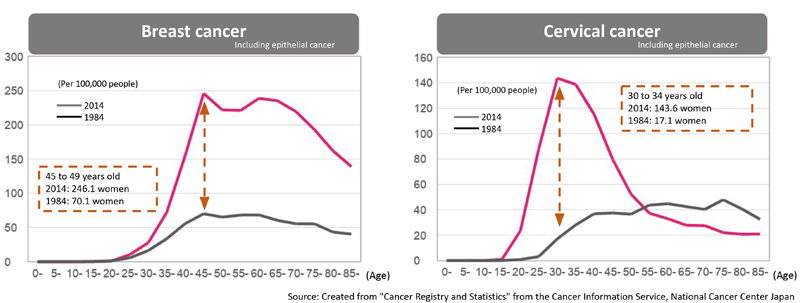
Cancers specific to women (1) breast cancer
- Breast cancer is the most common cancer specific to women, causing more than twice as many deaths than from traffic accidents.
- The number of women who have developed cancer has increased by about sevenfold in the past 40 years.
- Self-checks (self-palpation) and cancer screening are thus important.
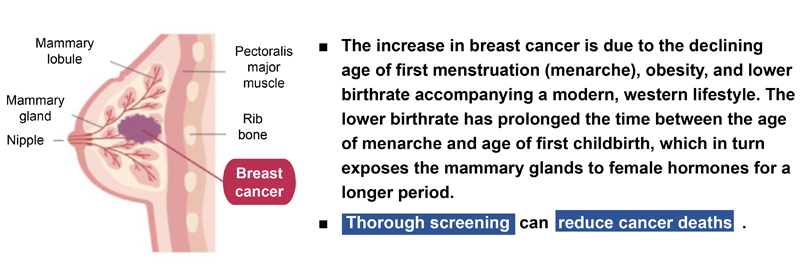
Self-check for breast cancer
- Regularly check your breasts once a month, four to seven days after your menstruation period ends.
- By examining your breasts by hand on a regular basis, you will be able to remember how each part feels to the touch. Even if you do not recognize any changes, make sure to get a mammography every two years.
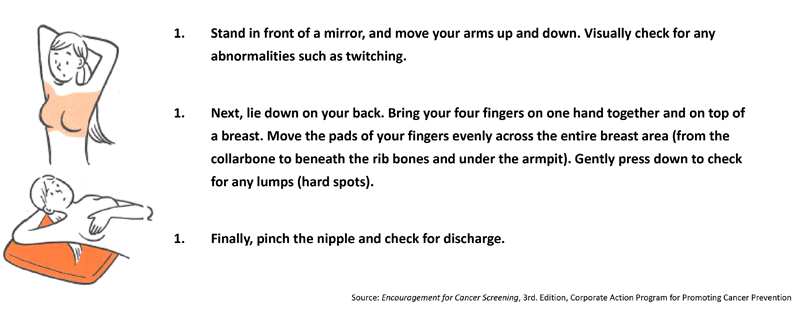
Cancers specific to women (2) cervical cancer
- The cause is a persistent human papillomavirus (HPV) infection.
- In recent years, with sexual intercourse starting at an earlier age, cervical cancer israpidly increasing in younger women in their twenties and thirties
- The magic bullet for them is to start cancer screening in their twenties.
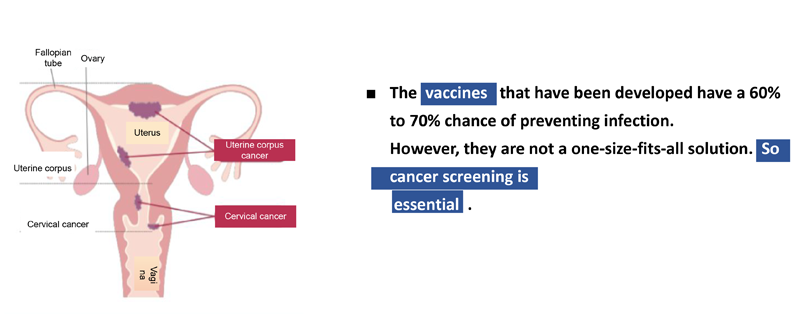
Even saints get cancer
- Not only should you practice a good lifestyle but also you need to try to get cancer detected early (cancer screening and self-check).
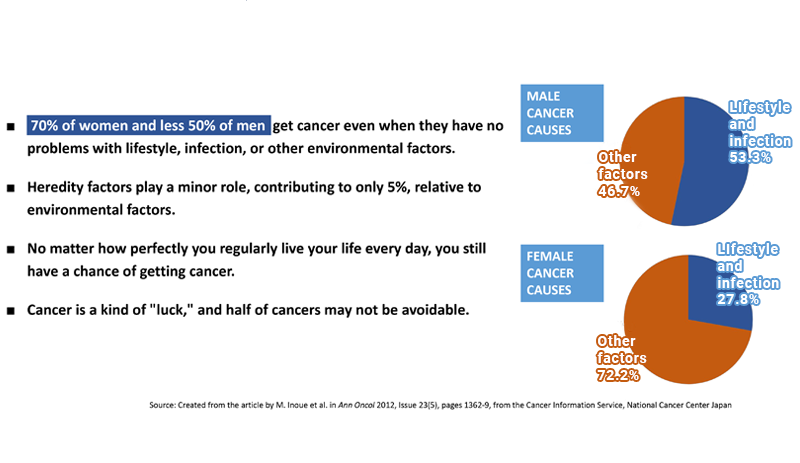
2.If you find cancer early, you can cure it while working
02 If you find cancer early, you can cure it while working
If you get cancer, will you ever get better?
- Taking all types of cancer into account,60% of cancers today are curable.
- Many types of cancer at an early stage arecompletely curable, at a rate of 90% or higher.
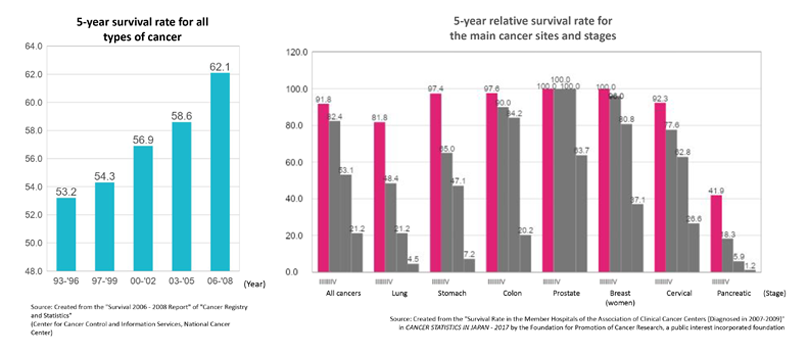
Era when people who have cancer are continuing to work
- Cancer treatment has shifted from hospitalization to outpatient treatment Most patients can get outpatient treatment at a hospital.
- According to 2019 statistics, 448,000 cancer patientsreceived treatment while they continued working.
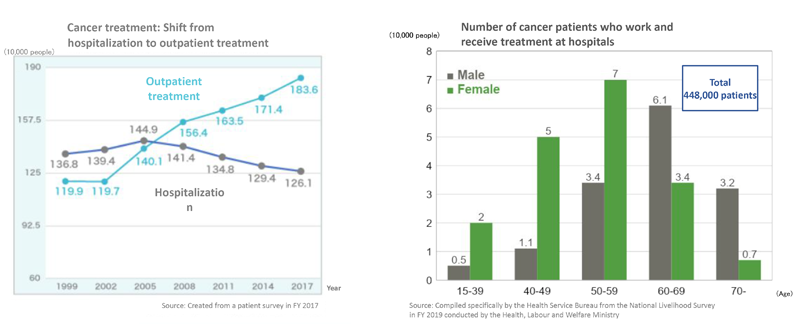
Cancer treatment
- The treatment depends on the type of cancer and stage of progress. Patients may be provided a combination of treatments including an operation (surgery), chemotherapy (anticancer drugs), and radiation therapy.
- The treatment tends to take a long time.
- Patients may sometimes experience a decrease in physical strength and/or side effects from the treatment.
To continue working while being treated
- Check the cancer control employment support handbook and check the system to continue working reasonably.
- Talk to your superior, industrial physician, manager as a contact point for HR Management Department, HR Management Department, or anyone else who can help you.
3.Let’s get cancer screening
03 Let’s get cancer screening
Cancer Screening
- Cancer screening recommended by the Ministry of Health, Labor and Welfare "Manual for Cancer Screening in Occupations" to reduce cancer mortality
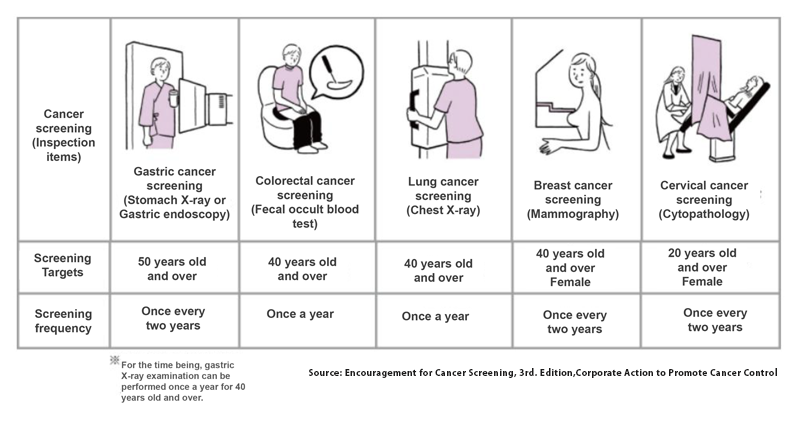
Importance of early detection
- Whether or not you get cancer screening makes a big difference in how far cancer has progressed by the time it is detected.
- Let’s get cancer screening for early detection.
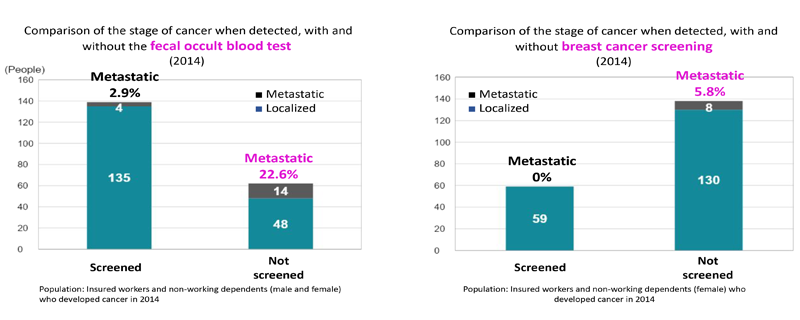
Get cancer screening regularly
- Cancer cannot be diagnosed until it grows to a size of about 1 cm.
- In most cases, when cancer can be detected early (2 cm or smaller), it is completely curable.
- Early stages of cancer present few subjective symptoms.
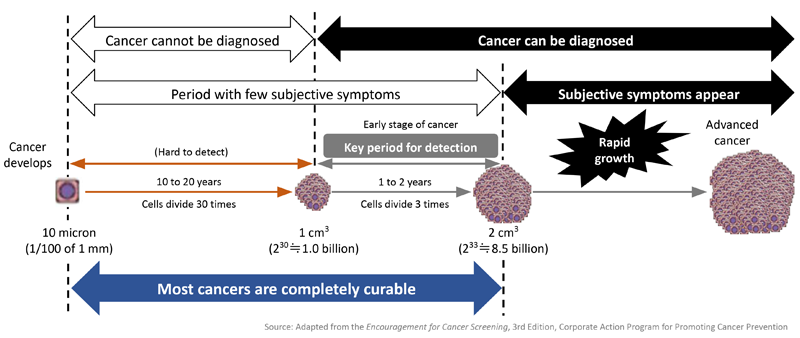
Importance of work-ups
- Cancer screening is effective only when a detailed examination or treatment is received.
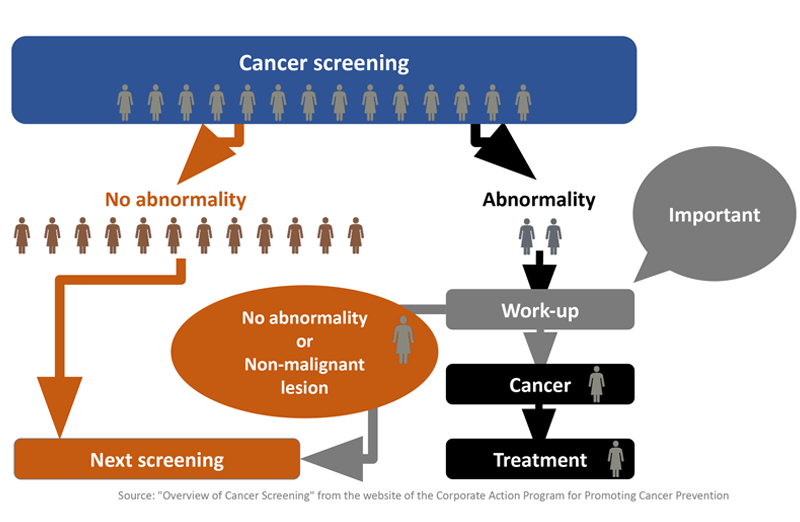
Cancer is like a traffic accident
- Though some accidents cannot be avoided, the risk would surely decrease if you paid attention!
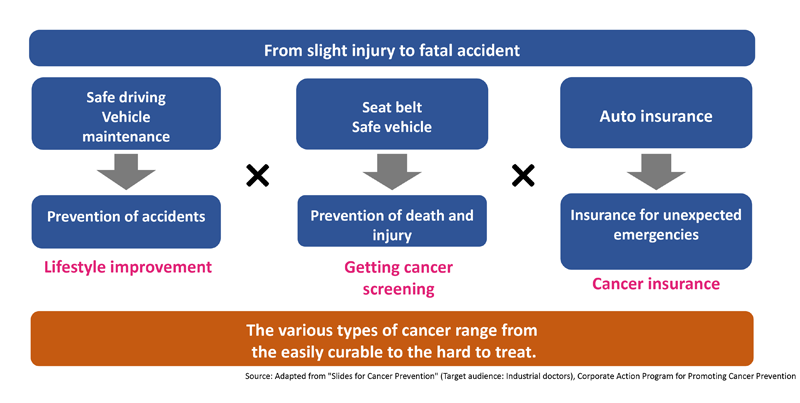
4.Support for balancing work and cancer treatment(mandatory training for executives)
04
Support for balancing work and cancer
treatment(mandatory training for executives)
Importance of a workplace where employees with cancer can work with peace of mind
- About one third of the people who get cancer are of working age .
- The aging workforce and the increase in the number of female employees will further increase the number of people who continue working as they get cancer treatments.
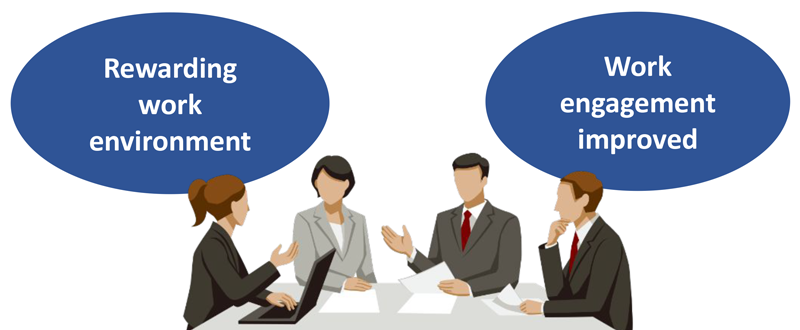
Basic knowledge of cancer treatments
- Cancer treatments do not end with the completion of surgery. Other therapies and follow-ups are required. Furthermore, patients may suddenly experience subsequent complications from surgery or the side effects of treatments.
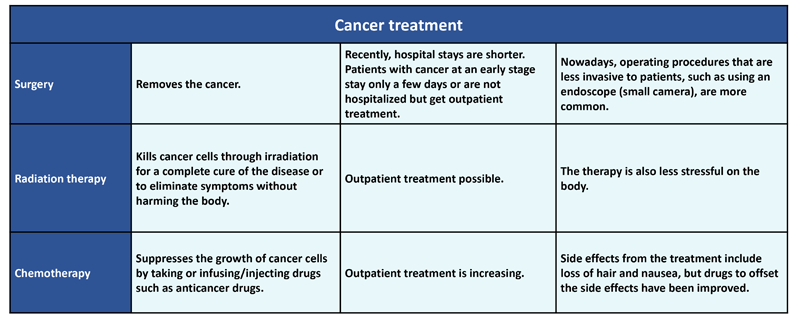
Key points when listening to workers with cancer
- Most people who are diagnosed with cancer temporarily feel a considerable amount of stress.
- They need someone to listen to them and understand why they are depressed.
- Try listening to them carefully by using counseling techniques.

- In principle, the contents of the consultation must not be shared. To solve problems, however, you may need to share them with your human resources department or industrial doctor to make adequate arrangements. After obtaining the consent of the worker with cancer to share information, you should collaborate with the relevant departments and take action as soon as possible while taking care not to disadvantage the worker.
Support for balancing work and cancer treatment
- To support a balance between work and cancer treatment, workers with cancer need to work together with all parties involved to get concrete support.
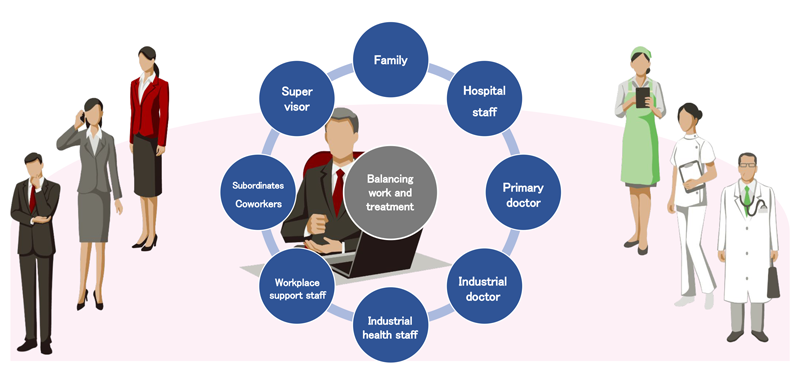
Cancer knowledge check
Cancer knowledge check
- Finally, let’s check your knowledge and awareness of cancer.
Read each statement and check the most relevant check box on the right.
| I know | I have heard this before |
I did not know |
||
|---|---|---|---|---|
| Q1. | Around two-thirds men develop cancer. | |||
| Q2. | Around half of women develop cancer. | |||
| Q3. | Cancer is the leading cause of death in Japan. | |||
| Q4. | Nearly one-third of Japanese die from cancer. | |||
| Q5. | The cancer mortality rate per 100,000 people in Japan is 1.6 times that in the United States. | |||
| Q6. | The peak age of onset of breast cancer is late forties. | |||
| Q7. | The peak age of onset of cervical cancer is early thirties. | |||
| Q8. | Even healthy individuals develop thousands of cancer cells (5,000) every day. | |||
| Q9. | At the early stages of cancer development, more than 90% of many types of cancer are completely curable. | |||
| Q10. | Localized cancer, which remains within the primary site, is relatively easy to remove completely. Cancer that does not remain localized but spreads to other parts of the body may be difficult to remove completely. Therefore, early detection by screening is very important. | |||
| Q11. | Because early stages of cancer present few subjective symptoms, cancer screening is important for detecting cancer before symptoms appear. | |||
| Q12. | People can be treated for many types of cancer without hospitalization while they continue working. | |||
| Q13. | Infection by bacteria or viruses may cause the development of cancer. | |||
| Q14. | Know the in-house system to support the treatment of illness. | |||
| Q15. | I know the in-house consultation desk for health. |
Your after-course e-learning knowledge score is...
Have a long way to go
Not bad, try better
Have moderate interest
Have high knowledge
-
30-26 points Have high knowledgeYou are familiar with and highly aware of "cancer".
Please proceed with learning in this course to reconfirm your knowledge. -
25-16 points Have moderate interestYou are interested in "cancer" and are constantly collecting information.
This course introduces a wide range of topics, from the mechanism of cancer onset to the measures that can be taken on a daily basis.
Deepen your knowledge through learning. -
15-6 points Not bad, try betterYou know general information about "cancer".
This course introduces a wide range of topics, from the mechanism of cancer onset to the measures that can be taken on a daily basis.
Deepen your knowledge through learning. -
5-0 points Have a long way to goYou don't seem to know much about cancer yet.
To deepen your knowledge, please proceed with learning in this course, which introduces a variety of topics regarding cancer, ranging from onset mechanisms to routine prevention practices.
This is the end of this study.
Good job for today.
The English version of e-learning, "This material has been designed for Japanese originally."
Reference
For more information about cancer, see the following websites (external sites).
- がん対策推進企業アクション
https://www.gankenshin50.mhlw.go.jp/index.html(in Japanese) - Cancer Information Service, National Cancer Center Japan [Cancer Information Service]
https://ganjoho.jp/public/index.html(in Japanese) - Cancer Institute Hospital of JFCR [Consultation & Visits]
https://www.jfcr.or.jp/hospital/conference/cancer/index.html - Japan Cancer Society (a public interest incorporated foundation)
https://www.jcancer.jp/(in Japanese) - Cancer Information Japan
http://cancerinfo.tri-kobe.org/(in Japanese)
Reference Information
Reference Information
Editorial Supervisor: Keiichi Nakagawa
Specially Appointed Professor of Therapeutic Radiology, Department of Radiology, University of Tokyo Hospital
Chairman of the Corporate Action Program for Promoting Cancer
Prevention/Chairman of the Cancer Control Council, Ministry of Health, Labour and Welfare
Member of the Study Committee for Cancer Education, Ministry of Education, Culture, Sports, Science and Technology
http://www.u-tokyo-rad.jp/staff/nakagawa.html(in Japanese)
Publisher: Asahi Press
- /


